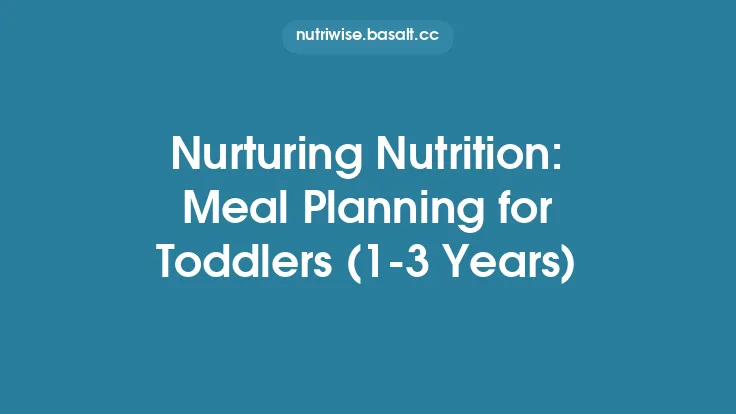Micronutrients are the vitamins and minerals required in small amounts, yet they play outsized roles in supporting growth, brain development, immune competence, and the establishment of lifelong health patterns. The first three years of life—spanning from birth through toddlerhood—represent a period of rapid physiological change, making adequate micronutrient intake essential for building a strong foundation. Below, we explore the specific needs of infants and toddlers, the biological rationale behind each nutrient, practical food‑based strategies, and considerations for supplementation when necessary.
1. Why the First 1,000 Days Matter for Micronutrients
The “first 1,000 days” (conception to roughly age 2) is a window of heightened plasticity. During this time:
- Cellular proliferation is at its peak; every organ system is forming or maturing.
- Neurodevelopment accelerates, with synaptogenesis, myelination, and neurotransmitter synthesis heavily dependent on micronutrients such as iron, iodine, zinc, and B‑vitamins.
- Immune programming occurs, establishing the balance between tolerance and defense. Micronutrients like vitamin A, vitamin D, and selenium modulate innate and adaptive immunity.
- Bone mineralization begins in earnest; calcium, phosphorus, magnesium, and vitamin D are critical for achieving optimal peak bone mass.
Because many micronutrient stores are limited at birth, the infant must obtain them continuously from diet (breast milk, formula, complementary foods) to avoid deficits that can have irreversible consequences.
2. Micronutrient Requirements by Age Segment
| Age Range | Key Micronutrients | Primary Functions | Typical Dietary Sources |
|---|---|---|---|
| 0–6 months (exclusive milk feeding) | Vitamin D (400 IU/day), Iron (0.27 mg/day), Zinc (2 mg/day), Vitamin A (400 µg RAE), Iodine (110 µg/day) | Vitamin D: bone health, immune modulation; Iron: hemoglobin, neurodevelopment; Zinc: DNA synthesis, growth; Vitamin A: vision, immunity; Iodine: thyroid hormone production | Breast milk (low vitamin D, iron, zinc); Infant formula (fortified with vitamin D, iron, zinc) |
| 6–12 months (introduction of solids) | Iron (11 mg/day), Zinc (3 mg/day), Calcium (260 mg/day), Vitamin C (15 mg/day), Vitamin A (500 µg RAE), Iodine (130 µg/day) | Iron: prevent anemia, cognitive function; Zinc: growth, wound healing; Calcium: bone mineralization; Vitamin C: collagen synthesis, enhances iron absorption; Vitamin A & Iodine as above | Iron‑fortified cereals, pureed meats, legumes, dairy (yogurt, cheese), fruits (citrus, berries), vegetables (sweet potatoes, carrots, leafy greens) |
| 12–24 months (toddler diet expands) | Iron (7 mg/day), Zinc (3 mg/day), Calcium (700 mg/day), Vitamin D (600 IU/day), Vitamin C (15 mg/day), Vitamin A (400 µg RAE), Iodine (130 µg/day), Folate (150 µg DFE) | Folate: DNA synthesis, neural tube closure (critical early but still important); other nutrients as above | Whole milk (after 12 mo), fortified cereals, meat, fish, eggs, beans, nuts (as appropriate), a variety of fruits and vegetables |
| 24–36 months (early toddlerhood) | Iron (7 mg/day), Zinc (3 mg/day), Calcium (1,000 mg/day), Vitamin D (600 IU/day), Vitamin C (15 mg/day), Vitamin A (400 µg RAE), Iodine (130 µg/day), Vitamin B12 (0.9 µg/day) | Vitamin B12: neurologic function, red blood cell formation; other nutrients as above | Similar to 12–24 mo but with increased portion sizes and greater variety (e.g., whole grains, lean meats, fish, fortified plant milks) |
*RDA = Recommended Dietary Allowance; RAE = Retinol Activity Equivalents; DFE = Dietary Folate Equivalents.*
3. The Role of Specific Micronutrients
3.1 Iron
- Physiology: Iron is a component of hemoglobin, myoglobin, and numerous enzymes involved in oxidative metabolism.
- Critical windows: Rapid brain growth (0–24 months) demands iron for myelination and neurotransmitter synthesis.
- Deficiency signs: Iron‑deficiency anemia (pallor, fatigue, developmental delays).
- Absorption tips: Pair heme iron (meat, poultry, fish) with vitamin C‑rich foods to boost non‑heme iron absorption; avoid giving tea or excessive cow’s milk (>24 oz/day) which can inhibit iron uptake.
3.2 Zinc
- Physiology: Cofactor for >300 enzymes, essential for DNA replication, protein synthesis, and immune cell function.
- Deficiency risk: Low‑zinc diets (e.g., exclusive reliance on cereals without animal protein) can impair growth and increase infection susceptibility.
- Sources: Meat, shellfish, legumes, fortified cereals, dairy.
3.3 Calcium & Vitamin D
- Physiology: Calcium provides the mineral matrix for bone; vitamin D facilitates intestinal calcium absorption and modulates immune responses.
- Infant considerations: Breast milk supplies calcium but is low in vitamin D; thus, supplementation is recommended for exclusively breastfed infants.
- Toddler sources: Whole milk, fortified plant milks, yogurt, cheese, fortified orange juice, fatty fish, sunlight exposure (10–30 min daily, depending on skin type and latitude).
3.4 Vitamin A
- Physiology: Supports visual cycle, epithelial integrity, and immune function.
- Sources: Liver (in small amounts due to high retinol content), sweet potatoes, carrots, pumpkin, dark leafy greens, fortified cereals.
- Safety note: Preformed vitamin A (retinol) can be toxic in excess; rely on beta‑carotene (pro‑vitamin A) from plant foods for safety.
3.5 Iodine
- Physiology: Integral to thyroid hormones (T3, T4) that regulate metabolism and neurodevelopment.
- Sources: Iodized salt, dairy, fish, seaweed (use sparingly due to high iodine content).
- Deficiency impact: Cretinism in severe cases; milder deficits can affect cognition and growth.
3.6 Vitamin C
- Physiology: Antioxidant, collagen synthesis, enhances non‑heme iron absorption.
- Sources: Citrus fruits, strawberries, kiwi, bell peppers, tomatoes.
- Practical tip: Offer fruit purees or soft fruit pieces as snacks; combine with iron‑rich foods.
3.7 Folate & Vitamin B12
- Physiology: Folate is essential for nucleotide synthesis; B12 is required for myelin formation and red blood cell maturation.
- Sources: Folate – leafy greens, legumes, fortified cereals; B12 – animal products (meat, dairy, eggs) or fortified plant milks for vegetarian families.
- Risk groups: Infants of mothers with low B12 intake (e.g., strict vegans) may need supplementation.
4. Breastfeeding, Formula, and the Transition to Solids
4.1 Exclusive Breastfeeding (0–6 months)
- Advantages: Provides optimal protein quality, bioavailable micronutrients, and bioactive factors that aid gut maturation and immunity.
- Limitations: Low vitamin D and iron content; therefore, the American Academy of Pediatrics (AAP) recommends 400 IU vitamin D supplementation daily for all breastfed infants.
4.2 Infant Formula
- Fortification: Commercial formulas are fortified with iron (typically 10–12 mg/L), vitamin D (400 IU/L), and other micronutrients, making them a reliable source when breastfeeding is not possible or supplemented.
4.3 Introducing Complementary Foods (≈6 months)
- Timing: Begin when the infant shows developmental readiness (sitting with support, loss of tongue thrust reflex, interest in foods).
- First foods: Iron‑fortified single‑grain cereals, pureed meats, legumes, and soft cooked vegetables.
- Progression: Gradually increase texture (from purees to mashed, then soft finger foods) and variety to expose the child to a broad nutrient spectrum.
4.4 Milk Transition (12 months onward)
- Whole cow’s milk: Recommended after 12 months to provide calories and fat needed for brain development, as well as calcium and vitamin D.
- Portion control: Limit to 16–24 oz per day to avoid displacing iron‑rich foods and to prevent excess protein load.
5. Practical Strategies for Meeting Micronutrient Needs
| Strategy | How to Implement | Example Meal/Snack |
|---|---|---|
| Fortified Cereals | Choose iron‑fortified, low‑sugar options; serve with breast milk, formula, or fortified plant milk. | ¼ cup iron‑fortified oatmeal mixed with breast milk, topped with mashed banana. |
| Protein‑Rich First Foods | Offer pureed meats, poultry, or fish early; they provide heme iron and zinc. | 2 oz pureed chicken mixed with sweet potato puree. |
| Vitamin C Pairing | Add a fruit or vegetable high in vitamin C alongside iron‑rich foods. | Lentil puree with a squeeze of orange juice. |
| Dairy Variety | Include yogurt, cheese, and later whole milk for calcium and vitamin D. | Full‑fat plain yogurt with finely diced soft fruit. |
| Healthy Fats | Incorporate avocado, nut butters (smooth, no added salt), or small amounts of olive oil to aid absorption of fat‑soluble vitamins (A, D, E, K). | Mashed avocado mixed into oatmeal. |
| Limit Cow’s Milk Before 12 Months | Use breast milk or formula as primary liquid; introduce small amounts of water only if needed. | Offer water only in a sippy cup after meals, not as a primary drink. |
| Supplement When Indicated | Vitamin D for all breastfed infants; iron for preterm infants or those with low birth weight; iodine if using non‑iodized salt. | 400 IU vitamin D drops daily from birth to at least 12 months. |
| Monitor Portion Sizes | Use age‑appropriate serving guides (e.g., ¼ cup cooked grains, 2 oz protein) to ensure adequate intake without excess calories. | Serve ¼ cup cooked quinoa with 2 oz shredded turkey. |
6. Recognizing and Addressing Micronutrient Deficiencies
6.1 Clinical Red Flags
- Iron deficiency anemia: Pale skin, lethargy, poor appetite, delayed motor milestones.
- Vitamin D deficiency (rickets): Delayed closure of fontanelles, bowed legs, bone pain.
- Zinc deficiency: Dermatitis around mouth and perianal area, growth faltering, increased infection frequency.
- Iodine deficiency: Goiter, slowed growth, developmental delays.
6.2 Diagnostic Approach
- Laboratory tests: Hemoglobin/hematocrit, serum ferritin, transferrin saturation for iron; 25‑hydroxy vitamin D for vitamin D status; serum zinc; urinary iodine concentration.
- Dietary assessment: 24‑hour recall or food frequency questionnaire to identify gaps.
6.3 Intervention Strategies
- Targeted supplementation: Prescribed doses based on age and severity (e.g., 3 mg/kg elemental iron daily for iron deficiency).
- Therapeutic foods: Iron‑fortified cereals, ready‑to‑use therapeutic foods (RUTF) for severe malnutrition.
- Education: Counsel caregivers on food preparation, feeding frequency (3–4 meals + 2–3 snacks), and the importance of variety.
7. Special Considerations
7.1 Preterm and Low Birth‑Weight Infants
- Higher needs: Up to 2–3 times the iron and zinc requirements of term infants due to reduced stores and rapid catch‑up growth.
- Supplementation: Early iron supplementation (2 mg/kg/day) often initiated at 2–4 weeks of age, alongside vitamin D.
7.2 Food Allergies and Intolerances
- Alternative sources: For infants allergic to cow’s milk protein, use extensively hydrolyzed or amino‑acid‑based formulas fortified with the same micronutrients.
- Avoid nutrient gaps: Ensure alternative calcium and vitamin D sources (e.g., fortified soy or rice milks) are used.
7.3 Cultural and Dietary Patterns
- Vegetarian/vegan families: Emphasize fortified plant milks, iron‑rich legumes, tofu, and vitamin B12 supplementation (400 µg cyanocobalamin weekly or daily 0.5 µg).
- Low‑salt diets: Use iodized salt sparingly but ensure iodine intake through dairy, fish, or supplements.
7.4 Socio‑Economic Barriers
- Cost‑effective options: Legumes, eggs, canned fish (low‑sodium), seasonal fruits/vegetables, and fortified cereals provide high micronutrient density at low cost.
- Community programs: Encourage participation in nutrition assistance programs that provide fortified foods and supplements.
8. Monitoring Growth and Development
Regular well‑child visits (at birth, 2 weeks, 1 month, 2 months, 4 months, 6 months, 9 months, 12 months, 15 months, 18 months, 24 months, and annually thereafter) allow clinicians to:
- Track anthropometrics (weight, length/height, head circumference) using WHO growth standards.
- Screen for anemia (hemoglobin) at 12 months and again at 24 months.
- Assess developmental milestones (cognitive, motor, language) that can be impacted by micronutrient status.
- Review dietary intake and reinforce feeding practices.
Early detection of growth faltering or developmental delay prompts a more detailed nutritional assessment and timely intervention.
9. Summary of Key Take‑aways
- The first three years are a critical period for micronutrient intake; deficiencies can have lasting effects on cognition, immunity, and bone health.
- Breast milk provides an excellent base, but vitamin D and iron supplementation are universally recommended for exclusively breastfed infants.
- Introduction of iron‑rich complementary foods at ~6 months, coupled with vitamin C to enhance absorption, is essential to meet the surge in iron needs.
- Calcium, vitamin D, and vitamin A become increasingly important as toddlers transition to cow’s milk and a more varied diet.
- Regular monitoring, caregiver education, and culturally appropriate, affordable food choices are the pillars of successful micronutrient adequacy in infancy and toddlerhood.
By prioritizing a balanced, nutrient‑dense diet and addressing potential gaps early, caregivers and health professionals can lay a robust nutritional foundation that supports optimal growth, brain development, and lifelong health.





